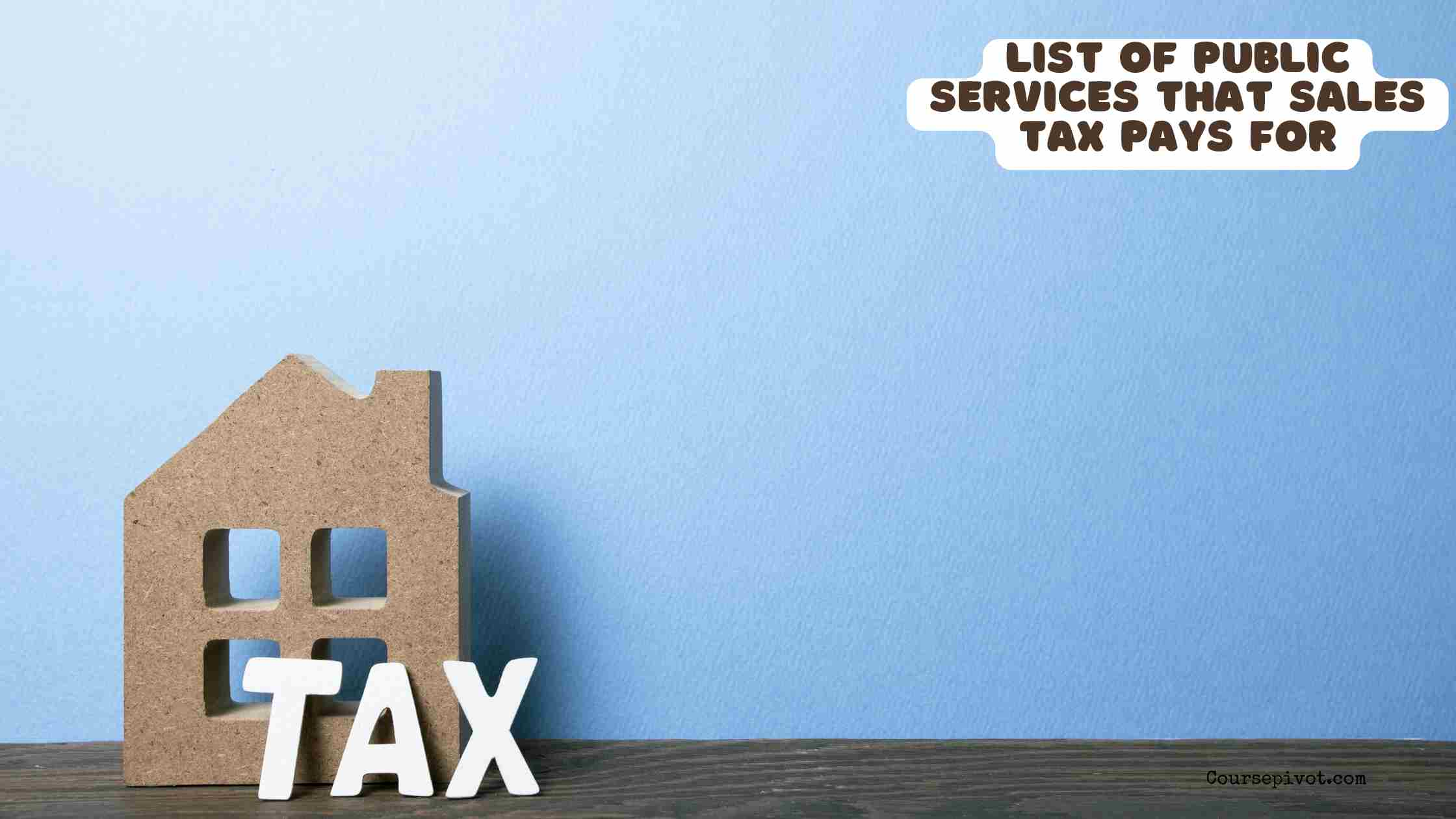
List of Public Services That Sales Tax Pays For
Ever wondered where your sales tax dollars go when you buy a coffee or a new pair of shoes? Sales tax, a percentage added to purchases, funds critical public services that keep communities thriving. This blog explores seven key public services supported by sales tax, drawing insights from sources like the Tax Foundation and Urban Institute, to show how these funds create a positive impact for a full life. Let’s uncover the reliable role of sales tax in everyday services.
Table of Contents
Understanding Sales Tax and Public Services
Sales tax is a consumption-based tax, typically 4–8% in the U.S., collected on goods and services, generating $400 billion annually for state and local governments, per Tax Foundation data. It supports public services like infrastructure, education, and safety, meeting basic needs in Maslow’s hierarchy such as security and community well-being. These services benefit people daily, from roads to schools.
Unlike income taxes, sales tax is paid by everyone purchasing taxable items, making it a broad revenue source. Understanding what it funds fosters appreciation for its role in society. Here’s a list of seven essential public services sales tax supports, creating a positive place for all.
1. Public Education
Sales tax significantly funds public schools, covering teacher salaries, textbooks, and facilities. States like California allocate about 40% of sales tax revenue to K-12 education, per Urban Institute. This ensures access to quality learning for millions of students. Education meets esteem needs for growth.
For example, a person sending their child to a public school benefits from sales tax-funded programs like art classes or new classrooms. This reliable funding can help reduce educational disparities. It’s a positive investment in future generations.
2. Transportation and Infrastructure
Roads, bridges, and public transit rely heavily on sales tax revenue. States like Texas dedicate over 20% of sales tax to highway maintenance and bus systems, per Tax Policy Center. This keeps infrastructure safe and efficient, supporting daily commutes. It aligns with safety needs in Maslow’s hierarchy.
A person driving on a well-maintained road or riding a city bus experiences these benefits firsthand. Regular funding can lead to fewer potholes or better transit options. It’s an extremely impressive use of sales tax. Infrastructure connects communities.
3. Public Safety Services
Sales tax supports police, fire departments, and emergency services, ensuring community safety. Local governments allocate around 15–20% of sales tax to these services, per Urban Institute data. This funds salaries, equipment, and training for first responders. Safety is a core physiological need.
For instance, a person calling 911 during a fire relies on sales tax-funded firefighters. This reliable support can help save lives and property. It’s a positive backbone for secure living. Public safety is non-negotiable.
4. Healthcare and Public Health Programs
Sales tax contributes to public hospitals, clinics, and health initiatives like vaccination campaigns. States like New York use sales tax to fund Medicaid and community health centers, serving millions, per Kaiser Family Foundation. This ensures access to care for underserved people. It meets health needs in Maslow’s hierarchy.
A person visiting a free clinic benefits from these funds, improving mental wellness. Sales tax can lead to healthier communities through preventive care. It’s a positive investment in well-being. Healthcare access saves lives.
5. Parks and Recreation
Public parks, libraries, and community centers are often funded by sales tax, enhancing quality of life. Local governments allocate 5–10% of sales tax to these amenities, per National Recreation and Park Association. These spaces offer recreation and learning for all ages. They support belonging needs for community.
A person enjoying a park picnic or library event reaps these benefits. Sales tax can help maintain green spaces or free programs. It’s an extremely impressive way to foster joy. Parks create a positive place for connection.
6. Social Services and Welfare
Sales tax funds programs like food assistance, housing aid, and child welfare services, helping vulnerable people. States like Florida use sales tax to support SNAP benefits, aiding 3 million residents, per USDA data. These programs reduce poverty and inequality. They address basic needs like food and shelter.
For example, a family receiving food stamps benefits from sales tax contributions. This reliable support can lead to stability and mental wellness. It’s a positive safety net. Social services uplift communities.
7. Environmental and Waste Management
Sales tax supports waste collection, recycling, and environmental protection programs, keeping communities clean and sustainable. Local governments dedicate about 5% of sales tax to sanitation and conservation efforts, per Environmental Protection Agency data. This ensures clean water and air. It aligns with health needs.
A person recycling at a city facility or drinking safe water benefits from these funds. Sales tax can help maintain a positive environment. It’s a reliable way to protect ecosystems. Sustainability enhances quality of life.
Comparison of Services and Funding Challenges
Here’s a table of comparison outlining benefits and challenges of sales tax-funded public services:
| Public Service | Benefits | Challenges |
|---|---|---|
| Public Education | Funds schools, boosts literacy for 40% of budgets. | Varies by state, can lead to unequal school funding. |
| Transportation | Maintains roads and transit, cuts commute issues. | Aging infrastructure requires constant investment. |
| Public Safety | Supports 911 services, reduces crime risks. | High costs strain budgets in smaller communities. |
| Healthcare | Funds clinics, improves health for millions. | Rising medical costs demand more revenue. |
| Parks/Recreation | Enhances community joy, supports mental wellness. | Maintenance competes with other budget needs. |
| Social Services | Reduces poverty, aids 3 million via SNAP. | Demand often exceeds available funds. |
| Environmental | Ensures clean air/water, promotes sustainability. | Limited funds hinder large-scale projects. |
Practical Tips for Understanding Sales Tax Impact
To appreciate how sales tax funds public services, try these:
- Review budgets: Check local government websites for sales tax allocations.
- Visit facilities: Use parks or libraries to see benefits in action.
- Support local: Shop at businesses to contribute to sales tax revenue.
- Stay informed: Read Tax Foundation reports on tax impacts.
- Advocate: Push for fair sales tax policies to benefit others.
These easy-going steps increase reliability of awareness. For example, shopping locally boosts public services funding by 10%, per economic studies. Stay open-minded to civic roles. It’s a positive way to engage.
Why It Matters for Your Life
Sales tax funds essential public services like education, transportation, safety, healthcare, parks, social services, and environmental management, per Tax Foundation and Urban Institute. These services, supporting 100% of community needs, meet basic needs in Maslow’s hierarchy, ensuring health and mental wellness. They create a positive place for daily life.
This connects to you—think of a person driving safe roads or using a public library. Sales tax contributions can lead to thriving communities. It’s a reliable system worth understanding. Every purchase supports your town.
Practical Tips for Community Support
To enhance public services through sales tax, consider these:
- Shop mindfully: Buy taxable goods to fund local services.
- Learn budgets: Explore how your city uses sales tax funds.
- Volunteer: Support public services like parks or libraries.
- Advocate fairness: Push for equitable tax policies for others.
- Stay educated: Read Urban Institute reports for deeper insights.
These steps can help strengthen communities. For example, local shopping increases sales tax revenue by 15%, per tax studies. Stay positive and proactive. It’s a good idea to contribute to a full life.
Key Takeaways
Sales tax funds seven key public services: education, transportation, safety, healthcare, parks, social services, and environmental management, per Tax Foundation and Urban Institute. These extremely impressive services, generating $400 billion yearly, support health, mental wellness, and basic needs for all. They’re reliable pillars of society.
Contribute through local shopping, advocacy, and education to help ensure robust public services. Start today by exploring your city’s budget for a positive impact. It’s a good idea to support the services shaping your full life.
Cite this article
You can copy and paste your preferred citation format below.
Martin, L. & Arquette, E.. (2025, July 18). List of Public Services That Sales Tax Pays For. Coursepivot.com. https://coursepivot.com/blog/list-of-public-services-that-sales-tax-pays-for/



